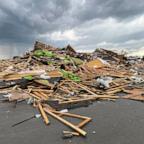Golden Gate Bridge turns 75
SAN FRANCISCO -- If the Air Force had gotten its way, the bridge would have been red with white stripes. Had the Navy won out, it would have been yellow with black stripes. In the end, consulting architect Irving Morrow prevailed, and the Golden Gate Bridge was coated in a vermilion shade dubbed International Orange.
Seventy-five years later, the bridge still sports that signature burnt-sienna hue. What is changing is the visitor experience. In coming weeks, major enhancements will be unveiled in celebration of this landmark anniversary. A sprawling waterfront festival is set for May 27, and commemorative events will continue throughout 2012.
The Golden Gate Bridge has long been a magnet — and not just for motorists crossing the San Francisco Bay, either. On pleasant summer days, up to 10,000 pedestrians and 6,000 cyclists take to the span. But because officials have focused on running a bridge, not a tourist venue, visitor amenities were lacking until now.
Among the new features designed to make recreational visits more comprehensive:
•A 3,500-square-foot Bridge Pavilion that will serve as an interpretive center, museum and gift shop with a new line of merchandise.
•The first-ever guided tours.
•A "green screen" photo area where visitors can pose as if they're standing atop the tower or climbing the cables.
•Renovation of the historic Round House into a staging area for visitors.
•A revamped Bridge Cafe at the south end of the bridge, offering more sustainable menu options.
Naysayers said the bridge could not — and should not — be built. Yet designer and chief engineer Joseph Strauss and his crew constructed the span in less than 4½ years. The structure became an instant icon and a symbol of new beginnings for newcomers to the West Coast.
"Its lure and magic are layered and textured," says Mary Currie, a spokeswoman for the Golden Gate Bridge Highway & Transportation District (GGBHTD) and a bridge historian. "It has this amazing grace and texture in an incredible setting. And to think these (engineers) were doing calculations on slide rules, and they came up with this bridge … it's amazing."
Jumpers pulled back
On a workaday level, the Golden Gate Bridge is a finely tuned, if bureaucratically complex, operation. The GGBHTD manages maintenance and operations. In all, five agencies deal with safety and security. A firetruck filled with 450 gallons of water is poised for action at its south end, as are four resident tow trucks. In the command center near the tollbooths, bridge patrol officers monitor the roadway.
Bike patrols traverse the walkways bordering the span, on the lookout for would-be "jumpers." With more than 1,400 suicides since its debut in 1937, the Golden Gate Bridge is widely regarded as the world's No. 1 suicide venue.
"Yesterday, I got two off the bridge in just one bike ride. One on the way out and one on the way back," Sgt. Bob Gelardi said in an interview in January. "It was a good day."
Patrol officers look for telltale behavioral signs, but they can't predict frequency.
"You may get three or four (suicidal people) on a 12-hour shift. You may get none," says Lt. Dan Brown, a 30-year veteran of the GGBHTD.
Why do they come here to jump? Because they can. Among the bridge's signature attributes are its wide, open sidewalks, a feature that has "brought a lot of joy and a little sorrow," Currie says.




